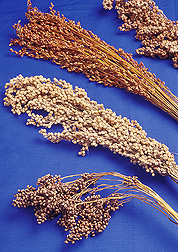This page has been archived and is being provided for reference purposes only. The page is no longer being updated, and therefore, links on the page may be invalid.
Read the magazine story to find out more. |
|
Sources of Sorghum Anthracnose Resistance Discovered
By Jim CoreFebruary 3, 2006
Agricultural Research Service (ARS) scientists scouring sorghum germplasm collections from African countries in search of anthracnose resistance for this valuable grain crop were surprised to find some key sources in unexpected locales.
Disease evaluation data are lacking for more than 50 percent of the 43,000 accessions in the ARS sorghum collection. Since pathogens can overcome plant resistance, researchers need to find new sources of resistant germplasm that breeders can use.
The United States produces about one-fifth of the world's sorghum and is the leading exporter of grain sorghum. But Africa is the center of origin for this plant, so research geneticist and sorghum curator John E. Erpelding of ARS' Tropical Agriculture Research Station (TARS) in Mayaguez, Puerto Rico, looked to sorghum collections from African countries for resistance to the highly variable anthracnose pathogen.
The fungus infects all aboveground parts of the plant and, in severe cases, the disease can kill plants before maturity. Often, anthracnose weakens the plant, severely reducing grain yield and quality.
Erpelding and Louis K. Prom, a plant pathologist at the ARS Crop Germplasm Research Unit in College Station, Texas, were not surprised to find resistance in about half of the lines evaluated from a subset of the Sudan collection, considered a center of diversity for sorghum.
But finding 80 percent of the accessions from a subset of the Mali collection to be resistant was unexpected. So, the researchers evaluated additional germplasm subsets representing specific regions of Mali and found an association between weather pattern and anthracnose resistance. More accessions from dry areas were susceptible, while nearly all from the wettest region were resistant.
Erpelding is working with ARS geneticist Robert R. Klein of College Station, who is mapping the sorghum genome and cloning important genes which could include anthracnose resistance.
Read more about the research in the February 2006 issue of Agricultural Research magazine.
ARS is the U.S. Department of Agriculture's chief scientific research agency.

